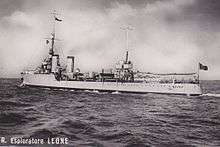Leone-class destroyer
| Italian destroyer Pantera | |
| Class overview | |
|---|---|
| Builders: | Ansaldo, Genoa |
| Operators: |
|
| Built: | 1921–1924 |
| In commission: | 1924–1941 |
| Planned: | 5 |
| Completed: | 3 |
| Lost: | 3 |
| General characteristics | |
| Type: | Destroyer |
| Displacement: |
|
| Length: | 113.4 m (372 ft 1 in) |
| Beam: | 10.36 m (34 ft 0 in) |
| Draught: | 3.1 m (10 ft 2 in) |
| Propulsion: |
|
| Speed: | 34 knots (63 km/h; 39 mph) |
| Range: | 2,400 nmi (4,400 km) at 16 knots (30 km/h; 18 mph) |
| Complement: | 206 |
| Armament: |
|
The Leone class were a group of destroyers built for the Italian Navy in the early 1920s. Five ships were planned and three completed. All three ships were based at Massawa, Eritrea during World War II and were sunk during the East African Campaign.
Design
The ships were designed as scout cruisers (esploratori), essentially enlarged versions of contemporary destroyers. They were initially ordered in 1917, but postponed due to steel shortages, and re-ordered in 1920.
Each ship of the class carried, for its size, an extremely heavy armament of eight 4.7-inch (120 mm) guns, paired into four powered turrets on the centre line. While only two guns could aim directly fore or aft, the all-eight-gun broadside was not matched by any other destroyer-type ship until the American Porter class destroyers of 1936.[1]
Operational history
The ships were outfitted for colonial service, and by 1935 they were deployed in the naval base of Massawa, Eritrea.[2] The ships were re-rated as destroyers in 1938 and fought in World War II, when the Italian entry in the war left Italian East Africa isolated from Italy.[3]
Attack on convoy BN 7

The only appreciable action in which the destroyers were involved was the attack on the Allied convoy BN 7, in the early hours of 21 October 1940. Leone and Pantera, along with the Nullo and Sauro, shelled the convoy and its escort, inflicting some splinter damage to the leading transport ship, especially on one of her lifeboats, and launched at least two torpedoes aimed at HMAS Yarra, which successfully dodged them.[4] The attack was nevertheless repulsed by the cruiser HMS Leander, which fired 129 six-inch rounds on the Italian destroyers. Leone, Pantera and Sauro successfully disengaged but Nullo was chased by HMS Kimberley and forced to run aground on Harmil island, where she was later wrecked by RAF Blenheim bombers. Kimberley took two hits on a boiler from coastal batteries, and had to be towed to Aden by HMS Leander.
Last mission
The destroyers remained at dock in Massawa until the very end of ground operations in East Africa. Their commander ordered them to steam out on 31 March 1941, for a naval bombardment against targets around the Suez canal, in a mission without return. Leone ran aground off Massawa, and was sunk by her sister ships. After being spotted and harassed by British aircraft, Pantera and Tigre reached the Arabian shores, where their crews scuttled them.[5]
Ships
| Ship | Laid down | Launched | Completed | Fate |
|---|---|---|---|---|
| Leone | 23 November 1921 | 1 October 1923 | 1 July 1924 | Wrecked on uncharted rock 1 April 1941 |
| Pantera | 19 December 1921 | 18 October 1923 | 28 October 1924 | Scuttled 3/4 April 1941 |
| Tigre | 23 January 1922 | 7 August 1924 | 10 October 1924 | Scuttled 3/4 April 1941 |
Two more ships Lince and Leopardo were cancelled in 1920 or 1921.
Notes
- ↑ Campbell, John (1985). Naval Weapons of World War Two. Annapolis, Maryland: Naval Institute Press. pp. 335–338. ISBN 0-87021-459-4.
- ↑ Cacciatorpediniere Tigre (Italian)
- ↑ Etnasi, Fernando (2007). Otto milioni di baionette: in guerra con le suole di cartone. EdUP, p. 72. ISBN 88-8421-170-0 (Italian)
- ↑ O'Hara, Vincent P. (2009). Struggle for the Middle Sea: the great navies at war in the Mediterranean theater, 1940-1945. Naval Institute Press, p. 103. ISBN 1-59114-648-8
- ↑ Jackson, Ashley (2006). The British Empire and the Second World War. Continuum International Publishing Group, p. 283. ISBN 1-85285-417-0
References
- Whitley, M.J. (1988). Destroyers of World War 2. Cassell Publishing. ISBN 1-85409-521-8.